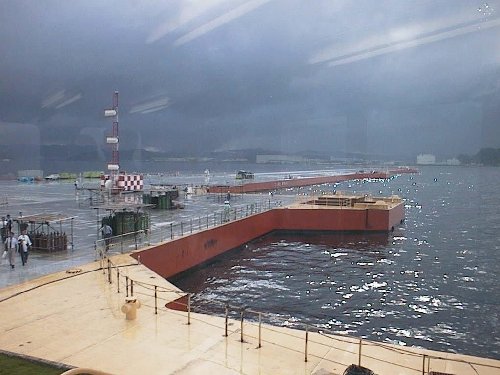Floating Airports
Today, let us hop across the ocean. The University of Houston's College of Engineering presents this series about the machines that make our civilization run, and the people whose ingenuity created them.
Lindbergh flew the Atlantic in 1927 by turning a specially designed Ryan monoplane into a flying gas tank. Over half its take-off weight was gasoline. When Burt Rutan's airplane, Voyager, circled the world nonstop in 1986, its takeoff weight was eighty percent fuel. Fuel in a three-stage rocket greatly outweighs the space shuttle it carries into orbit. Any long trip that has to be made without refueling poses a problem of diminishing return.
At the time of Lindbergh's flight, it appeared that crossing the Atlantic nonstop would be very inefficient. Two years later, the Curtiss-Wright Company proposed that America should be served by a system of small airports, each within a few hundred miles of the next. Longer flights, while possible, were not feasible. How then could we establish transoceanic air service?
Canadian/American engineer Edward Armstrong began selling a solution to the problem fourteen years before Lindbergh's flight. Armstrong hoped to build strings of floating airports, called seadromes, across the Atlantic. A seadrome was to weigh fifty-thousand tons and have an eleven-hundred-foot-long deck. Its flotation system would extend about 180 feet into the water. To hold it in place, Armstrong went to John A. Roebling and Sons. Roebling had invented wound-steel cable, and his company had built the Brooklyn Bridge forty years earlier. Now they designed a deep-water anchoring system for Armstrong.
Author Stewart Nelson tells how each seadrome would include a forty-room hotel, café, lounge, and other amenities. He also tells how, on October 22nd, 1929, the New York Times announced that construction of the first seadrome would begin within sixty days. Seven days later, on what we now call Black Tuesday, the stock market crashed, and the Great Depression was upon us.
Armstrong struggled on. He almost gained PWA support for the project. Nelson tells how, in 1934, he briefly had Roosevelt's interest. All the while, airplane engines were improving, and the feasibility of nonstop transatlantic service increased. In fact, the great Zeppelins already provided such service.
Ideas, however, turn and evolve. Armstrong's dream had pretty well died by the end of WW-II; but, driven by new needs, the Japanese built a one-kilometer-long floating airport in 1999. They called it Megafloat. They meant to create offshore airports that don't consume the precious land of crowded coastal cities. That was the same thing that big seaplanes achieved until they were doomed because their high-drag profiles limited them to low speeds.
So Armstrong's seadromes are still with us, but they've split in two. That same design has evolved into the floating offshore oilrigs, but now we're also considering the idea of floating coastal airports. Thus we see, yet again, how no inventor ever knows just where any invention will really come to rest.
I'm John Lienhard, at the University of Houston, where we're interested in the way inventive minds work.
(Theme music)
Nelson, S. B., Airports Across the Ocean. Invention and Technology Vol. 17, No. 1, Summer 2001, pp. 32-37.
For some descriptions of Megafloat see: http://www.mlit.go.jp/english/maritime/mega_float.html

Photo of the Japanese Megafloat, from the US Navy web site above